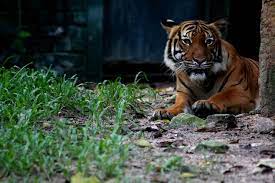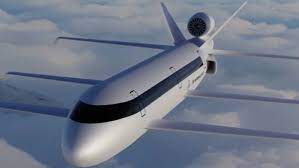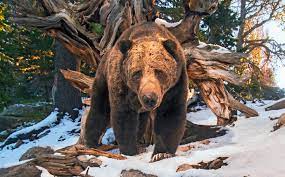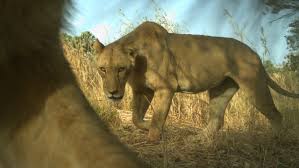A company owned by the Pahang states royal family plans to mine iron ore from a forest reserve that currently hosts a variety of important mega fauna, including tigers elephants sun bears and leopard.


Wildlife and conservation new, wild travel information and links for booking
A company owned by the Pahang states royal family plans to mine iron ore from a forest reserve that currently hosts a variety of important mega fauna, including tigers elephants sun bears and leopard.

While proportionally a small percentage of human emissions, the emissions of seafaring trade currently amounts to roughly 2% of our emissions.
The thing is, that with the huge advances in wind technology it would be possible to save a great deal of money and emissions.
A recent test of a ship kite, was found to save 10-15% (the creater of one of these systems suggested saving of 20% or more) of the fuel per day, a saving of $1000-1500 – which is quite something. While the kite systems currently cost a million or so, this will still be paid of in a couple of years. Furthermore this price is likely to fall as the technology becomes more mainstream.

In past governments indigenous land was out of bounds, yet under Bolsonaro there is currently 1265 requests to mine in Indigenous territories pending. This behaviour is prohibited by the Brazilian constitution, which shows how bad this is. If the mining is illegal what is the ned for it to even be looked at?
Given in these cases this land has been given over to the tribes, it is not the governments to hand over to miners.
The big concern is that even if Bolsonaro is voted out after just one term, he may have destroyed most of the countries remaining forests and indigenous areas, meaning there will be little for his replacement to save.
One of the companies wrote to Mongabay after the article was originally published, they claimed that they did not know anything about it. Unfortunately the record of the request is clear, and it is worth noting that while denying the existence, they did not cancel any of the requests at all
Jair Bolsonaro and his supporters are getting frustrated. The whole world can see that the direction the country is taking is extremely dangerous. Rather than changing tack they have decided to silence the detractors.
Whether environmental researchers, academics or officials, it seems that no one is safe. Increasing numbers of these professions are being forced to seek safety abroad to avoid threats to their lives.
This is not the behaviour of a democracy leader, and it wont work
Much of the deforestation that is occurring in Brazil is to make more room for cattle grazing. The promise of a beef giant to stop deforesting in 14 years is not worth anything. Apart from anything, it is likely that the have calculated that it will take 14 years to clear the land that they currently have access to.
A promise to reform your bad behaviour in 14 years is worth nothing. Indeed in a new Soy and Cattle deforestation tracker, JBS scored 1 point out of 100. As a point of context, its nearest competitors scored 40 and 46 out of 100.It has congratulated itself as the first company in its industry to make commitments, but no one else is impressed. They have had to many chances, now we must move away from buying their product.
The fact that they felt they needed to make a commitment would suggest that market pressure is working, clearly there has not been enough pressure bought to bare on this group. A boycott would likely be a good move. Morrisons Aldi Sainsbury and Lidl all buy meat from this company. My suggestion is that you buy your meat from companies which actually worry about things like this – If one of these companies are forced to drop this beef supplier, it is likely to force the others to do the same. They managed to get good converge last September, when they remade a commitment that they originally made in 2009 to halt deforestation through its suppliers – the bigger question should have been why havent you lived up to your 2009 pledge. It should be noted, the forests they are clearing are not grown for wood, they are old growth natural woodland, coming with it are the tens of thousands of species that are endangered or eradicated as their forests are lost.
JBS has consistently worked to keep their supply chain as opaque as possible, presumably to avoid being held accountable. They have now had enough time, and so it is time for action. If you shop at any of the food chains above, ask about where the meat comes from, and avoid any beef that does not have its origin clearly labelled.
We may not have rainforests to cut down in the UK, but if you continue to eat JBC meat, you may as well have got out the axe yourself.
The human race has been emitting carbon at an extreme rate for several centuries. Before we started burning things for the energy locked up inside them, the worlds carbon sinks and its carbon taps were in relatively stable harmony. For long periods of the earths existence, carbon absorbed by plants equalled the carbon emitted by breathing and volcano eruptions among other sources.
There are a variety of other carbon sinks. The earths oceans absorb carbon, while they can absorb huge quantities of carbon, this acidifies the water, which means that we dont want to rely on that to to great an impact.
Continue reading “Is one of our carbon sinks less reliable than we thought?”The last time that I wrote about a potential Airline disrupter was back in late March. Interestingly, the source article was written back at this point but I didn’t find it for a few months.
In this case, the change is in design rather than in the fuel (the last article on planes was looking at using biofuels made from algae. I should note, that this is probably possible to power any aircraft, so both changes could team up.
In this case, rather than changing the fuel, the layout of the plane was changed. Rather than 1 relatively thick wing, they replaced it with 3 thin wings distributed along the body of the plane.

One of the main advantages of this design, is that there is no natural rotating point. Generally the tail of the plan is required to keep the plane flying level (this tail is recognized as one of the most problematic parts of the plane in terms of efficiency).
Why is this design exciting? Well this plane would have a carbon footprint 70-80% lower than current aircraft. This means that it is incredibly cheap to run, and therefore cheaper for passengers to fly on. Also of interest is the fact that this design makes the aeroplane far safer. Due to its higher efficiency it can also fly an incredibly long way – 10,500 miles, far enough to easily fly London to Australia ( this would suggest that perhaps in the future, non stop flights to new Zealand are not too far off). Another advantage, is that due to its low drag coefficient, it would fly at 690 miles per hour (mach 0.9) – more than 100 miles an hour faster than normal passenger jets. In a similar way, London to Johannesburg would be a little over 8 hours.
So this plane would be cheaper to fuel, fly further and faster. It is predicted to be far cheaper to maintain, and to have a life span of twice current planes. It would have a wider body, so take more passengers than normal. It has a high lift coefficient, allowing it to take off from shorter runways, allowing it to access more of the world. Due to the how thing the wings are, they would not be able to store fuel anymore, so this would have to go in the proper body of the plane – current plans would be at the top of the plane over the passengers. As well as having a lifespan of roughly 50 years, it is thought that each plane will take half as long to build.
Whether we see an aircraft like this is anyone’s guess. Moving to one engine at the rear of the plane, probably rules out electric propulsion, though who knows. Of course with wings as slim as this it is unlikely to be able to accommodate dispersed power.
It is unfortunately true, that we are so close to climate disaster that we need all large countries to move as one on mitigating climate change. What is to happen if just a few refuse? An article from a few months ago spells this out, and its not good.
If China Russia Brazil and Australia all follow up on the pledges that they made on carbon reduction the world and the rest of the world followed their example, we as a planet would be looking at warming of 5°C rather the 1.5°C that scientists tell us is needed in order to avoid terrible impacts.
Continue reading “What do we do, when the plans of just a 4 countries could doom us all?”Back in 1975, the American Grizzly bear was declared endangered. With only minor differences, the American Grizzly bear is the same species as the European bear, that lives from Western Spain, through Europe to the Kamchatka bear of far Eastern Russia.
In 1975 the USA lower 48 states grizzly bear population numbered somewhere between 136 animals and 312, so it was essential that it was protected. Nowerdays the same 48 states have a population of around 1500, but given that this number would have been as high as 50,000 when people started migrating to the USA in large number, this recovery is only just getting going.

In some ways, recent discoveries should have been made long ago. Asiatic lions historic distribution stretched across Asia, north Africa, and Southern Europe.
Given that the Barbary Lions historic range covered the central part of this huge area, it seems reasonable that the Barbary lion and the Asiatic lion should be closely related. Yet it was only in the last few years that genetic evidence has been shown that this is indeed the case.
